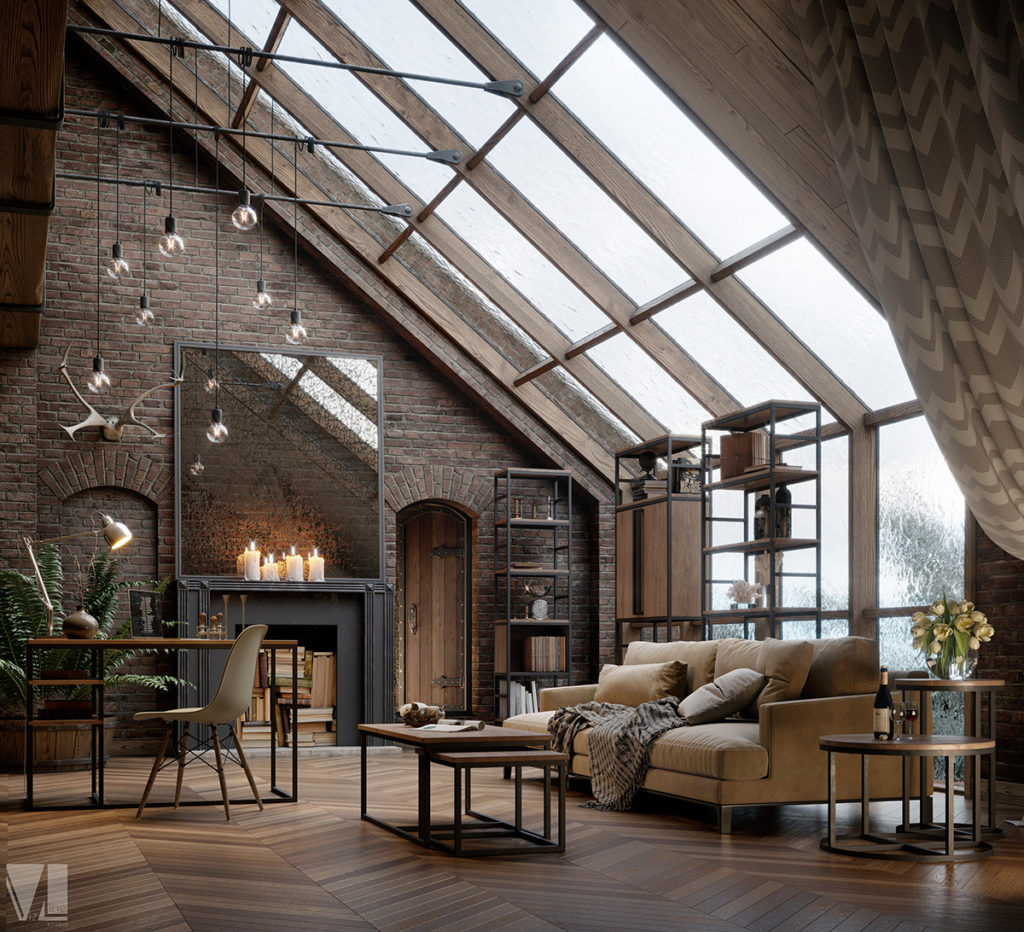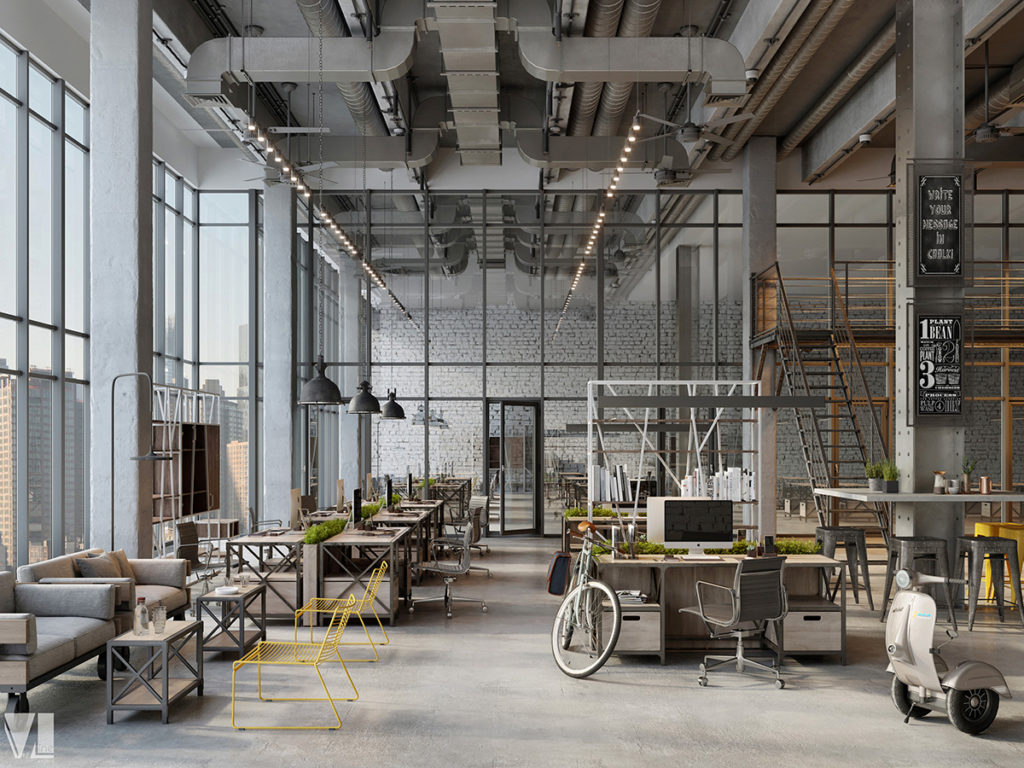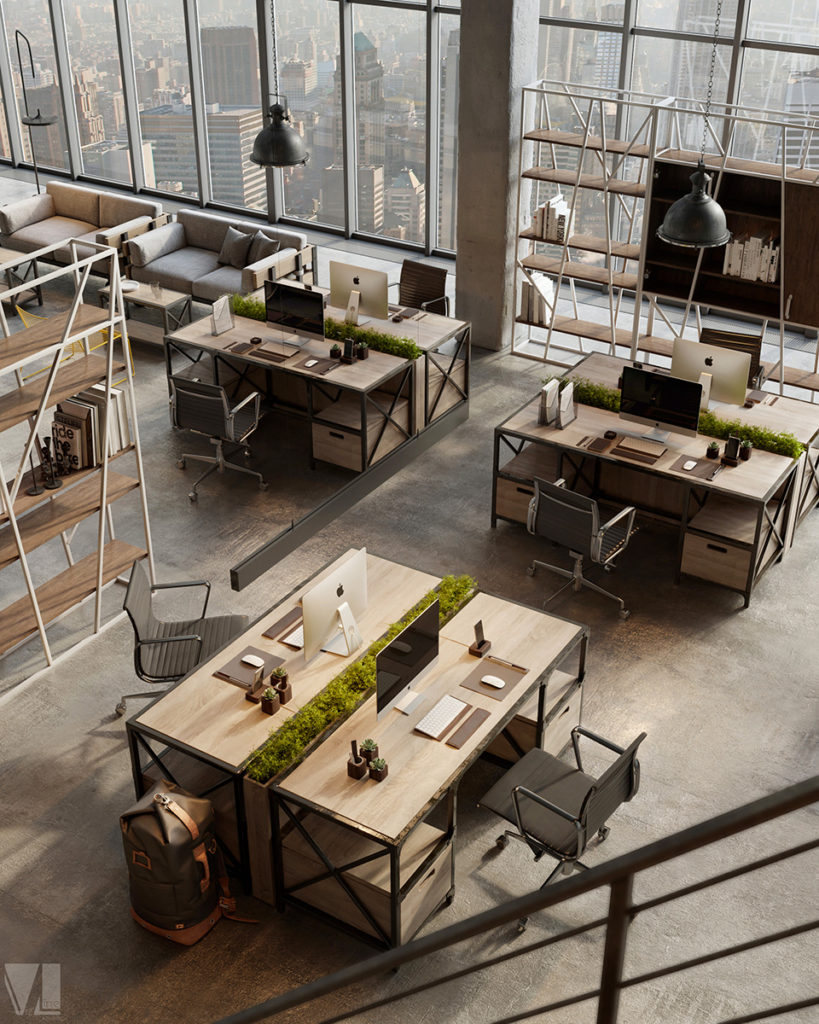Brief:
Head office: Minsk, Belarus
Number of employees: 7
Expertise: interiors, exteriors
You can find VizLine Studio:
– How did each of you get into 3D? How was your studio formed?
Maxim: I will start talking about myself. My name is Maxim. I have been doing 3D visualization for 8 years. I have a degree in architecture, successfully graduated from college and university. Moreover, I have working experience in different companies in the position of an architect and a visualizer (a little bit). During my working as a freelance visualizer, I was starting to get more and more orders. It was then when I realized that my freelance work is very exciting for me. Besides, I didn’t have to worry about my finances anymore. So I decided to work for myself.
Roman: My story is almost the same, actually. Maxim and I studied in the same educational institution. At first, we graduated from the Minsk College of Architecture and Construction. Our first specialty was technician-architect. Later we graduated from the Belarus National Technical University, the faculty of architecture. We have known each other for a long time, since 2006. But we started working together 3 years ago.
Maxim: From September 1, 2016.
Roman: We have gone back a long way. I’ve been doing visualization for a little longer, for about 9 years. When I studied at the university I was also working from home in the architectural bureau. I was designing the concept and then drew it in 3D. After graduation, I carried on with some extra projects in addition to our main work. When the volume increased significantly, Maxim offered to try working together. He was not able to meet the tight deadlines alone and wanted to improve the quality. So we started doing visualization projects together.
– And how many people work in your office?
Maxim: 5 people including us. Plus 2 people work from home permanently. They live in Ukraine and cannot move.
– Why exactly from Ukraine, were you unable to find any locals?
Maxim: We have lots of smart guys. Visualization schools in Belarus and in Ukraine are among the best ones. But now it is fashionable to work for yourself. Not everyone wants to work for a company, they consider it to be not as profitable as freelancing. Maybe they are looking for a slightly different job. Respectively, interests sometimes diverge.
We work in Minsk with people whom we get on very well. The guys from Ukraine have been standing by our side for a long time. We have been working with them for two years. We feel comfortable together. Now we are trying to attract more people and it turned out to be a big issue. We’re not able to find anyone for already half a year. A person we seek for should be interested in working with us and must meet our requirements at the same time.
– How do you test people? Do you give them any test work or just view their portfolio? What does the hiring process include?
Roman: Definitely, the portfolio tells us about its creator. Due to this, we find out what specialist is the applicant in 3D visualization, what are his skills as an artist. If the works in the portfolio are worthy, and their level satisfies us, we ask an applicant to do a test task. It is not too big and not necessarily done totally for free.
We expect the result of the test task to match our expectations. It also aims to test how the person works, to see how they communicate with us, understand us. If we would get on well. People sometimes do very good works, but they don’t hear what they are being told. They do not understand what is wanted from them. They just do it in a way they see it. But it’s business. This is a commercial job the important part of which is communication with the customer. First of all, it is necessary to fulfill the customer’s requirements. And only then realize own ambitions, artistic visions, etc.
– Can you give an example of such a test task?
Roman: Let’s take the project of a house or apartment. A potential employee can be given some small room in it. For example, a bathroom, a bedroom or a small bath joint with a toilet. The bathroom, in my opinion, is such a space that is quite difficult to design. It is necessary to correctly set the light.
Artificial lighting. How a person deals with it. There are lots of small details, too. Tile, trim, plumbing, decor, materials, etc. The room should be beautiful, bright, cool. This is a serious indication of how a person will cope with such a task. When I first started working, my first task was to render a small bathroom.
– Do you do only interiors in 3D? Or whatever the client wants? Exteriors, product-design, furniture, etc.
Maxim: We have 2 main directions: exterior and interior visualization. What’s about subject visualization and modeling I can tell that it all depends on the project. For example, people who manufacture furniture can order us modeling of upholstered or cabinet furniture. Usually, such companies task us with the interior for this furniture, too. They want to see how the furniture will fit in their interior.
If we are talking about some serious things, for example, animation, then we would say no. We don’t undertake it due to significant labor costs. We have a small studio and almost everyone is engaged in a personal project. Of course, sometimes people can work on several projects together. Usually, it is no more than two or three people. Never had it happened that all the team was engaged in only one project. I think Roman will take my point of view that such projects as animation in large residential complexes are time-consuming and labor-intensive.
– Is it because animation rendering that expensive?
Maxim: Yes. Such orders sometimes come to us. Most often, we refuse to take them. We are not at this level so far. We are comfortable with this stage, there is room for improvement.
– When you refuse to take a project, do you recommend someone?
Maxim: If we are asked to recommend someone, we recommend them. We recommend those of whom we are 100% sure. Every recommendation is a responsibility. The portfolio will not tell how its owner really works with the customer. Sometimes we regret to decline some projects, but we are physically unable to take them all – there is lots of work to do. Sometimes, we ask customers to wait. They agree if they like how we do our job.
– Were there any difficulties at the initial stage of the studio creation?
Roman: Like all beginners have. It was difficult to work with foreign customers, to organize the working process and documentation.
– What’s the problem with them?
Roman: Mostly, language knowledge. It was necessary to understand what a person wants us to do. If it is clear with the Russians, dealing with foreigners has its own specific features. When we moved onto a more serious level, opened the organization, there arose difficulties with paperwork. Workflow, contracts, and everything related to this, taxes, etc. This is a serious burden.
Over time, the structure of work with the customer, the stages of image visualization development are formed. From what we start, the stages we go through, what the result would be. The terms on which we agree to do the task. It doesn’t form right away.
The customer corrects his work, makes some changes. Sometimes he does not quite understand what he wants or you don’t understand what he wants. Now we have structured the stages of work with the customer, so we explain how we will cooperate and always reflect this in documents. Then everything becomes quite transparent and understandable. If contentious issues arise we solve them in accordance with certain clauses in the contract and always try to find a common language with the customer.
– One of the main problems of many companies is finding customers. Haven’t you faced such a challenge?
Maxim: Thankfully, we have not encountered this problem. We posted our portfolio initially on the Behance. The main flow of customers began to come from there. It turned out that customers began to find us themselves. We started developing our Instagram, created pages on other social networks. Another part of the orders came from there. We don’t do any search ourselves. Some customers find us themselves, some from recommendations.
– What do you think about difficult customers? Sometimes clients delay with revisions, delay with answers. Do you believe that being a difficult client is the client’s fault or is it most likely the inability of the freelancer or the studio to cope with the project well?
Roman: Of course, it is bad when such problems arise or any conflict situations with the client. This happens if a person does not understand what exactly we are doing, what we can do, and what we cannot. This is the first moment.
Secondly, we ask them to stay in touch with us. Sometimes clients take a timeout and go away. We are lucky if they tell us about it. Sometimes people just disappear. We do something, send the intermediate result to them and do not receive any feedback at all.
Thirdly, when the customer does not understand and does not want to understand what he wants. We realize that not all people are designers and architects, so we always ask and try to clarify the information as much as possible. Our task is to organize the whole process. In turn, customers’ task is to explain what they want from us. Only then we will tell them what we need to do to achieve the desired result.
The work is very easy and fast if there is interaction, and the customer provides materials, gives feedback. If the customer does not like something, and we try to guess then a conflict happens.
Maxim: The issue is rather sensitive. A person has a certain vision of the desired result when he contacts us. And here we are talking about a productive working process when both sides are satisfied with the result. When the cooperation ends unsuccessfully this does not mean that the customer is bad. He just sees it in a different way. For example, color. Some people like red, some like green. And they start to argue on this matter. We are trying to be flexible. As they say, the customer is always right. It is difficult to say for sure. A person may be good himself, but we are unable to find a common language.
Roman: We do not give up orders. If we have agreed and have begun to work we carry on with it to the end. We are trying to elevate the project to a certain level. Sometimes happens that the customer is not satisfied with the first outcome. He tells us about it. We do some adjustments. Usually, everyone is happy in the end.
– I’m interested in your working way from the beginning to the very end. How do you evaluate the cost of work? How do you assign responsibilities?
Maxim: Let’s take an example. We are tasked with a project. If we are talking about foreign customers, the whole project is mainly divided into several rooms. It can be a living area, a kitchen, a bedroom, a study, a bathroom, anything. If it is a public building, then the hall, stage, etc.
We usually divide by room if our guys are working. Someone gets a bedroom, someone gets a kitchen, etc. Again, we should consider the workload. There are always some “loose ends”. Never does it happen that we ended one project and are waiting until the second one begins. There are always some time frames when we are waiting for materials from another customer. At this moment we are starting to work on the parallel project. We share responsibilities among the guys on the complexity of the room depending on their workload.
If we are talking about orders from Russian customers, there is the same room division. If someone is not able to keep up with the work, we can redistribute responsibilities. But it is an uncommon practice for us when a worker finishes up someone else’s task. This would rather happen in case of an emergency. For example, an employee is ill and you need to finish the project quickly. Usually, we divide the zones and each one is done by one person.
As for the exteriors, one person does the landscape, the other is engaged in buildings modeling. Another employee does the visualization when the model is ready. There is an alternative possible approach: one makes the whole exterior visualization, from the beginning to the end.
– How do you evaluate the project cost? In some studios, customers are immediately given a price. In others, you need to send materials first. How does the project evaluation process go?
Maxim: We take the second approach. Each project is unique. Each customer needs his requests to be implemented. We always ask them to describe the project as much as possible. What we are needed to do, how much work needs to be carried out, approximately evaluate how long it would take. And only then do we give a price. Of course, we have a price list containing approximate prices to understand the pricing of certain areas or rooms.
– Do you evaluate projects based on the number of working hours, or based on the number of renders that the client requests?
Maxim: On the render basis.
– What projects are the most interesting for you? Are there any types of favorite projects? Are there any projects that you don’t like to undertake?
Maxim: My favorite projects are that when the customer gives the ‘green light’ and says, ‘Do what you want and what you can!’ When we send him a draft, he’s thrilled, we’re thrilled, and everyone is happy. This is an ideal project for us. Here we can open up from the side of conceptual design. How we see this room, its exterior or interior.
Roman: Minimum of restrictions.
– And does it happen often?
Maxim: Sometimes. Probably 20-30 percent of the entire workload. We should note that these projects are much cheaper than the usual ones. We take them because they are interesting for us and can benefit our portfolio.
Of course, problematic projects are more expensive. But at the same time, we do not get satisfaction from the working process. There are no ‘unfavourite’ projects. We always try to think positively. There are people with a certain style of communication. When talking we understand that the results of cooperation with this customer will be bad. Then we refuse to work on his task.
Sometimes, the project is dragging on for a very long time. Some of the projects we had been doing for almost a year although they were not very big. They had a lot of intermediaries. We’ve waited too long for an answer or there were many adjustments. Of course, they were paid. But sometimes it is too exhausting to redo the same over and over again. You are ready to do them for free, just to finish the project. That type of projects is probably the most ‘unfavourite’. They can be characterized as an endurance marathon who is winning over whom. And you have to put up with it, gritting your teeth.
– Can you tell us about the studios’ failures? Were there any?
Maxim: That happened one time. There were only isolated cases of serious failures when the client has not paid, or we somehow ended projects on raised voices. There were questions with payment. We told them our opinion on this matter and finished cooperation.
There was one customer with which we encountered in the very beginning when we had only started running the company. We signed a contract with him which he wanted us to sign. Because of our inexperience in this matter, we did not study the contract in detail. For a long time, we could not get rid of him, as we were forced to comply with the terms of the signed agreement. After this incident, we always make our own contract and prescribe our conditions in it.
Roman: Sometimes the customer provides his contract. We study it carefully and discuss all the issues. We learned from that case. It is very important to take seriously all the documents that you sign. Otherwise, you will be very surprised and upset when some unpleasant minutiae arise.
– In 3D visualization, we can say there are two camps, especially in architecture. There are people who do everything in 3D. There are people who do only a small part in 3D and do everything else in post-processing. What is closer to you and why?
Maxim: It is easier for us to do everything in 3D. And post-processing of finished images is minimal.
Roman: This is much more convenient in terms of adjustments. When the work is 50% drawn in Photoshop it is more difficult to make adjustments according to the customer’s wishes. You need to do your task in 3D first, spend a lot of time, and then spend the same amount of time on post-processing of each round. And when everything is in 3D it can be corrected easily and, respectively, the second part of the work can be seriously reduced.
– How do you assess your experience in visualization on a 10-point scale?
Maxim: I think about 6-7 points, but no more than 7. Nice number.
– And in what areas would you like to improve your knowledge? Are there any of them?
Maxim: Now VR started to gain some attention but I do not think it will continue to do so. Basically, customers need static pictures. These are images made for real estate companies, used in booklets, on banners, in extensions. It is hardly possible to use VR here. Although some companies prefer to do, for example, a walk around the apartment in VR. This is impressive for a person that is not familiar with 3D possibilities.
– Do you take part in non-commercial projects?
Roman: There are many things on which we would like to work. To do a case for a portfolio, team up with someone. We had such plans. But we lack the resources both human and time. We wanted to make a super-duper global project, very cool for the portfolio. To qualitatively draw a crazy concept, but it all stayed in plans, unfortunately. Maybe we will get around to it.
– Do you attend 3D conferences? In person or virtually?
Maxim: If these are some lessons about 3DsMax, like modeling, texturing, light exposure, I think we have passed this stage. If these are events attended by quite serious artists who made a name in this sphere, we have not been to them. But this is an interesting topic. I know that guys at the end of last year went to Lviv – there was a conference. We did not attend it because of the heavy workload before the New Year. But I think we really need to visit it. It is interesting to exchange the experience and not only in the field of visualization, but in the field of communication with the customer as well. Also to meet our guys in real life, to establish useful connections, they are always helpful.
– And how is your training going? You said some workers may be more experienced or less. Are you leveling up them by trying to teach? Or it’s every man for himself? How does this happen?
Roman: Definitely, we have teamwork. We never leave a person alone. If someone works on a project we evaluate it on every stage of its development and it is always discussed by the whole team. Some adjustments are made. Everyone has their own outlook. Therefore, we communicate, express our opinions, suggest how and what to modify, to correct technically.
Max: Yes, I’ll interrupt Roman a little bit. Even if we do something together with Roman, we always ask the guys to look afresh and we take their points of view into consideration. We do not have a practice of sending anyone to business forums. People always face some challenges and depending on how they solve them, they gain more experience.
I noticed a remarkable tendency: it is logical that each person has his own style, his own handwriting because everyone has their own preferences. As a rule, the work of a new employee differs in style. It is good, cool, wonderful, but it differs from the general style of our studio. And we explain to the employee how to make it equally cool but in a way we usually do. Over time, the handwriting is assimilated. All our guys’ renderings become similar, get a corporate identity.
That’s good. When several people are working on one apartment, too much style variation confuses the customer. This is one apartment, one living unit, consequently, the images should be similar, because this is a single complex work. Group communication and teamwork align different styles and fit them into the stylistic framework of the studio.
– Can you say that your company has developed its own style in 3D visualization? Handwriting that’s different from the others?
Maxim: Yes, something like that.
– What is closer to you? Do you want to remain a small 3D Studio, or do you want to grow? What are your ambitions, goals?
Roman: I probably would not want to grow up into a large studio with a staff of, for example, 50 people. The more people there are, the less you manage to monitor everyone. This is where art directors come into action whom you should trust completely and they must fully agree with your point of view. I do not want to become such a company that makes a visualization on the stream like on the pipeline. I want to keep our distinctive style. Make cool things that people would like.
– What do you think about competitors in your country? Are there any and are you afraid of them? Are they afraid of you?
Maxim: I don’t know if they’re afraid. Competitors are everywhere, not only in our country. So to speak, we have an international profession. We work in Belarus but during last year and a half, we did not do any project for our country.
– Is there a difference between customers from America or Europe?
Roman: Nothing that special, maybe style differs a bit. For instance, if they are Arabs, we imagine gold. Europeans seem to be more modern although the meaning of the word “modern” is probably different from everyone. We like the European market more, but there are no such distinctive differences. The customer comes, tell us what he wants. They are like us in terms of communication. But in terms of work stages development, we rather impose the way we work.
– Don’t you feel pressure from cheaper, less educated visualizers?
Maxim: In fact, there is no pressure. For any customer, there is a contractor who will do in a way the customer wants. Sometimes, they say, ‘I need to do it simply, quickly and cheaply’. We do not undertake such orders. Terms ‘quickly, efficiently and cheaply’ are mutually exclusive. We position ourselves as a studio that makes a quality product with good lighting, materials. Our portfolio speaks for us. People come and say: ‘We want to have something similar like here’. That’s how we work.
– Do you think your profession will be in high demand in the future?
Maxim: The artist’s profession was in great demand before the invention of the photo-camera. They painted portraits because there was no other way to get the image. When the cameras were introduced it said the artist would not be needed anymore. It is expensive, long and the photo will change everything. But the artist’s profession is still in demand.
Again about the photography. Everyone has a camera on the phone. But the profession of the photographer is alive. Absolutely anyone can take 100 pictures a day. But he can’t do that in a way a professional can. The professional and amateur level will remain completely different. That is the case with professional visualization too.
– What are your plans for the future?
Roman: We want to expand a little, a lot of orders have begun to come. Unfortunately, we have to decline them, because of the lack of resources. We also want to try ourselves in different areas, like animation.
And we want to promote our style, our vision further and not in terms of popularity, but in terms of recognition. When you see the work, you know immediately that it was made by this studio. This is the main goal for us which we would like to achieve. To be recognizable.










